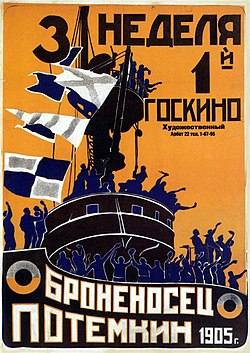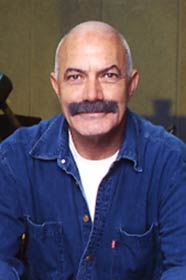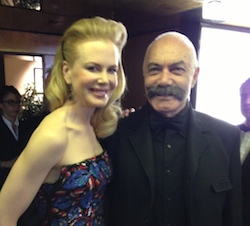National Silent Film Day: September 29
Battleship Potemkin is widely considered to be one of the greatest films ever made.
Directed and co-written by Sergei Eisenstein, Battleship Potemkin is a visually striking dramatization of the 1905 muting , when the crew of the Russian crew rebelled against their officers.
The film is a prime example of the montage theory of editing: the “Odessa Steps” scene became a widely influential, often recreated in later films, both European and American.
In 1924, the Proletkult Theater decided to sponsor a series of eight films, to be collectively entitled “Toward the Dictatorship of the Proletariat,” about the rise of the Communist Party from the late nineteenth century through 1917. Produced Proletkult-Goskino (the State Film Operation), Strike (1924) was intended to be the fifth of the series, but it became the first and only one.
Grade: A (***** out of *****)
| Battleship Potemkin | |
|---|---|

Original Soviet release poster
|
|
Initially, Eisenstein knew little about the technical aspects of film. He began as apprentice to the best cinematographer at Goskino, Eduard Tiss, who then became his lifelong collaborator. He made a promising debut with “Strike,” which led to a bigger assignment, a commemorative film about the revolution of 1905, a movie that contained a sequence about a mutiny on board the battleship Potemkin. Eisenstein then decided to restructure the whole film, entitled “Potemkin,” around the mutiny
The port town of Odessa was the story’s setting. Looking for exciting yet authentic locations, the director found a great flight of marble steps leading down to the harbor, and decided to stage the film’s major scenes on those steps, depicting Cossack soldiers leading a brutal reprisal against helpless and innocent populace.
History was made with this film’s sequence, particularly the scene that depicted a mother who carries her wounded son up the steps, while Cossacks prepare to shoot another round on the panicked citizens below. The Odessa steps sequence is a powerful recreation of what it’s like to be caught in the midst of random violence. As the soldiers march down the stairs, their movement is intercut with people running and faces terrified of the horror. A soldier slashes angrily at the camera, and the director cuts to a close-up of an old woman whose face is torn open.
That film’s most famous imagery, a baby carriage bumping down the steps, heading toward disaster–until it miraculously stops–became so influential that many directors imitated, copied, or paid tribute to it in their work, including Brian De Palma in The Untouchables (1987).
After the massacre, the mutineers expect another battle, but the sailors on the other ships, moved by the courage and camaraderie of their comrades, and sickened by slaughter, refuse to shoot. Instead, united in their defiance, all of the crews join in solidarity, led by Potemkin’s sailors.
Eisenstein’s principle of kineticism meant a jagged, dynamic and intense movement within the frame, as well as in the cutting between separate shots.
He generally employed diagonal composition and placed his subject slightly to the left of screen-center. Every minute of the film is broken up into a series of clashing shots (sort of a Marxist thesis, anti-thesis and synthesis). Eisenstein’s disjunctive method of editing reflected his dialectical philosophy, but it was also a necessity, due to the primitive equipment and poor film stock.
A Soviet classic, once revolutionary propaganda (tsarist oppressors shoot brave peasants!), “Potemkin” remains a timeless blueprint for modern techniques of “montage,” which articulated the process of editing images together. As noted, Eisenstein worked with the experienced newsreel and then film cameraman Edward Tiss, who taught him technique. Their fruitful association lasted through most of Eisenstein’s work.
As in most of Eisenstein’s work, the heroes are not figures with individualistic characteriostics, but more of social types that represent the collective mass. In this respect, too, Eisenstein contributed to the various sociological notions of characterization in narrative cinema.
Critical Status
In the 2022 “Sight and Sound” critics’ poll, it was voted as the 54th greatest film of all time; it had been placed in the top 10 in previous editions of thatmagazine’s poll.
Credits
Directed by Sergei Eisenstein
Written by Nina Agadzhanova, Eisenstein (uncredited), Grigori Aleksandrov (uncredited). Nikolai Aseyev (intertitles), Sergei Tretyakov (intertitles)
Produced by Yakov Bliokh
Cinematography Eduard Tisse
Edited by Eisenstein (uncredited), Grigori Aleksandrov (uncredited)
Music by Edmund Meisel
Production company: Mosfilm
Distributed by Goskino
Release date: December 21, 1925
Running time: 74 minutes
Silent film with Russian intertitles
Sergei Eisenstein’s Life (1898-1948)
This section draws on various sources, including David Cook’s chronicle.
Born in Riga, Latvia in 1898 to a well-to-do architect and city engineer father, he was educated at the Institute of Civil Engineering in Petrograd. In 1917, when his parents departed for Europe, he joined the Red Army as an engineer for two years, then worked as a set designer and director for the Moscow Proletkult Theater, an institution that had 200 branches across the country, and was established in order to replace the bourgeoisie culture with a proletarian one.
A member of the avant-garde of the late 1910 and early 1920s, Eisenstein was influenced by Meyerhold, from whom he learned the possibility of mixing two contradictory artistic approaches: rigorous systematization and spontaneous improvisation. His encounter with bio-mechanics made him obsessed with the psychological effects of the aesthetic experience, centered on the question of what combination of aesthetic stimuli will produce what responses in the perceiver-receiver under what conditions
Eisenstein elaborated in the theater the concept of “montage of attractions,” units of impressions combined into one whole, which then introduces “a new level of tension.” Before he entered the realm of cinema, he developed a theory of montage as a process whereby independent–at times arbitrary–units of “attraction” or “impression” were assembled to produce a new, total emotional effect, which was different from the sum of its parts.
Sergei Mikahilovich Eisenstein was, along with American D. W. Griffith, one of the pioneering geniuses of the modern cinema.
Both directors worked on an epic historical scale. However, if Griffith was a sentimentalist with values of the Victorian middle class, making films modernist in form but conservative in feeling, Eisenstein was a contemporary Marxist intellectual, innovator in style and form. Griffith was unschooled and narrowly-educated, whereas Eisentsein was a modern renaissance man.
Absorbing Freudian psychology, he later replaced the notions of attraction with that of shocks or stimuli.
Eisenstein fell out of favor during the Stalin’s regime due to his Jewishness and homosexuality.
He spent some time in Hollywood, but never made an American film.
Impact
Unfortunately, Eisenstein completed only 7 films in his 23-year-career.
Nonetheless, the impact of his work was comparable to Griffith. Translated into many languages, his theoretical writings on film form were influential for decades.
As several scholars have noted, Eisenstein formulated a modernist theory of editing based on psychological perception and Historical Marxist Dialectics. It was the first time that cinema communicated on its own terms, without borrowing in matter or form from other media. Like Griffith, Eisenstein left a few films that rank high among aesthetic achievements of the cinema.










